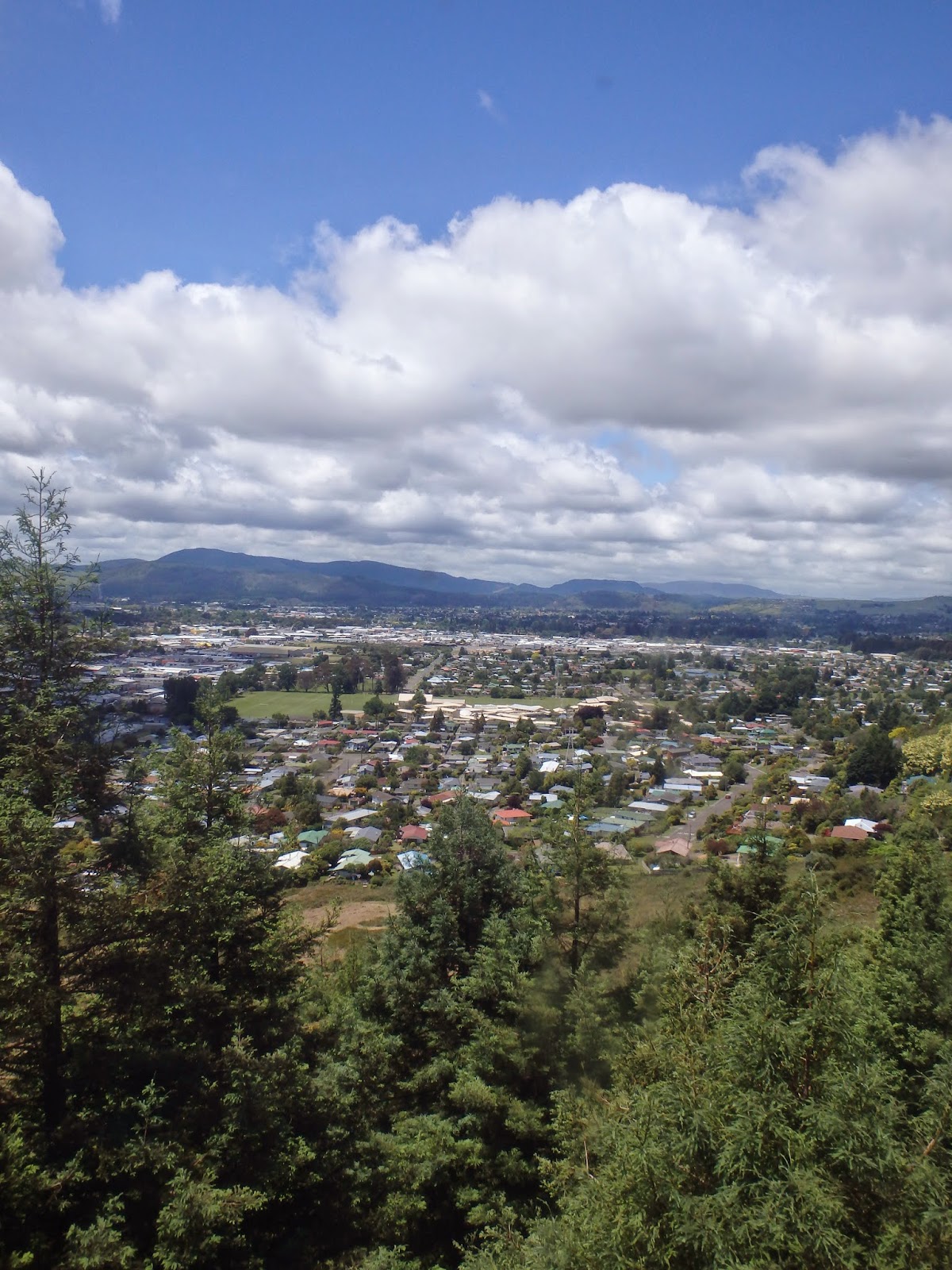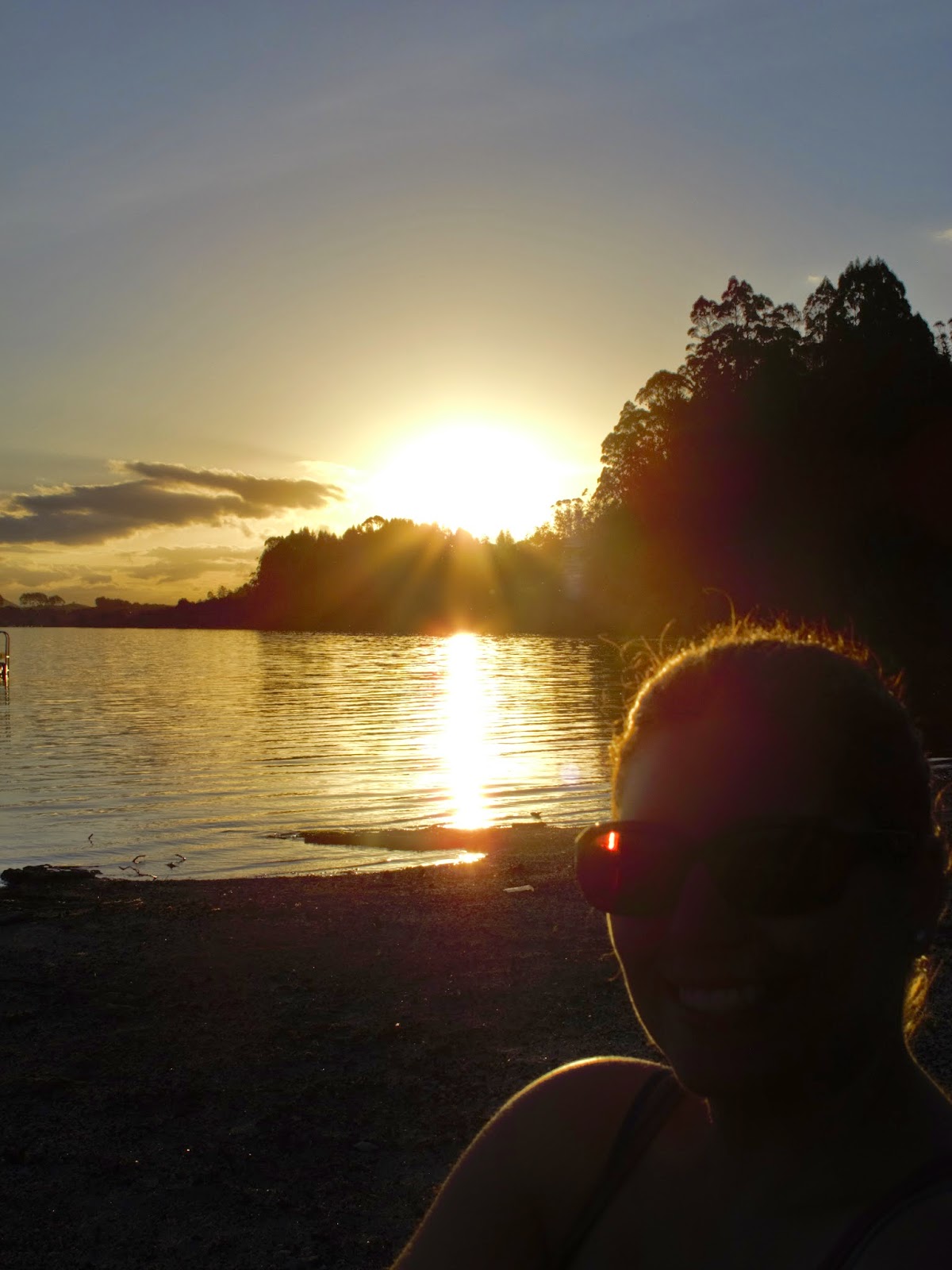After a decent night's rest, we packed up the cars and headed down the road to the tourism hotspot of Rotorua. Through yet more farmers fields and this time several fields of kiwi plants, we coasted onward across New Zealand. As we approached the town of Rotorua, we started to see the many lakes that dot the countryside. We were fortunate enough to come across one with a pair of black swans close to the bank. Mom being on bird patrol, was captivated by these majestic creatures, pruning in the shallows.
Once we arrived in town, we immediately detoured to the redwoods. Getting out and stretching our legs, we trodded off into the underbrush with the ancient redwood trees towering around us. In the shade of the canopy, we enjoyed the numerous ferns and jokingly hummed the theme to Jurassic park. This of course brought up one advantage to wandering through the forest in New Zealand to that of Canada, being that there are no carnivorous mammals such as bears or coyotes to worry about.
With an increased sense of adventure, we wandered into Rotorua to find our next great adventure. New Zealand is well known for its outdoor extreme activities and sports, and although we would be forgoing the bungee jumping and sky diving, we decided to participate in the downhill luge. So we all scrambled into our gondola and headed up the mountainside. The view over Rotorua was well worth the trip up alone, with forests and hills framing the lake and small town.
Now first of all, I do not have any pictures of the luge to which I apologize. We were so gung-ho to go riding down the mountain on these essentially go-kart style sleds that I forgot to just take some generic pictures, so I will just describe the situation. The cement tracks that the sleds traversed weaved around each other much like the New Zealand roads and people were sliding all over the place at variable speeds to their skill and comfort. Geoff and I were the first to go, but found ourselves quickly overtaken by Mom, Derek, and Dad who came screaming down the track terrorizing any and all other drivers on their way down, several of who blocked Geoff and I far behind our group. This was followed by a ski-lift venture back up the mountain, which was by far my least favourite part given my aversion to heights. Everyone enjoyed the sledding so much though that we were tempted to go again, but were under schedule to get back to the bottom to see some Kiwi's. Before heading down, we stopped in a Jelly-Belly shop which was adorned with art recreated using only jellybeans. Mary-Ellen thoroughly enjoyed these remarkable pieces of art and took a bit of crafting material to go.
Once again we headed down in the for more secure gondolas and reconvened in the parking lot for a trunk buffet of peanut butter and jam sandwiches. Conveniently located adjacent to the gondolas was the Rainbow Springs Park, who run a kiwi rehabilitation centre. For Mary-Ellen and I, we have yet to see a kiwi and were quite excited to hopefully see one up close.
Unfortunately for everyone else, photography was not allowed so you will have to go once again on my description. From the first viewing room, we were able to see multiple incubators turning and heating the roughly 12 cm eggs that had been retrieved from radio tagged kiwis. These eggs are carefully monitored for growth and will hatch in the little incubators with a little miniature kiwi emerging. These kiwis are moved to larger pens where they remain until release. The upside of this program is that the baby kiwis do not imprint on the human handlers, and as such, when released into the wild they retain their natural instincts to avoid humans. One of the downsides is that they have to be hand fed at this point to make sure they get a healthy diet. We were fortunate to have someone there feeding a kiwi, and got to see our first glimpses of this iconic creature. When she pulled it out, there was a small fuzy brown creature squirming and shaking its head in defiance. The almost fur like quality of the feathers was apparent through the glass as the handler sat in a chair and pulled up the dish of pureed material. Unlike the wriggling insects and worms this small creature is instinctively looking to eat, the special diet containing insects, important vitamins, and minerals in the form of small little uncooked meatballs did not move and thus was unappetizing to the young kiwi. Instincts in this case were quite troublesome, as the small kiwi refused to open his beak to eat even when the handler moved it around in her fingers to simulate wriggling. In the end she had to open the beak with her fingers and put the food between his beak where the little kiwi quickly gobbled it down.
Awestruck at this mysterious inhabitant of these mystical isles, we reluctantly moved on to see some adult kiwis in their enclosures. First walking in, it was the similar dark and low lit enclosures I remembered from the zoo. Unlike the zoo however, these kiwis were indeed out and about, probing the ground and digging. These creatures seemed almost alien to someone from North America, where a flightless bird, even though nocturnal, would likely have a hard time surviving the numerous nocturnal mammalian carnivores. It is only in the isolated isles of New Zealand, limited in its terrestrial predators, could such an animal survive. It gives one a new perspective on introduced species when you see these amazing animals and think that one of their greatest threats to survival are possums, ferrets, rats, stoats, cats, and dogs, all of which are non-native.
We were all pretty pleased to have had the opportunity to partake in this encounter, but found our energy levels dropping quickly. We wandered through the rest of the park, admiring other local birds, reptiles, and the enormous trout in every waterway. We also got a glimpse of some very old animals, one of which is believed to be the closest living relative to some of the great dinosaur species, the tuatara. This lizard is reasonably unique for the third eye it has at birth which quickly is enveloped in skin. We also got to see a statue of one of New Zealand's extinct flightless birds, the Moa, which would have towered well above even Derek.
The park finished and some dinner in us after a lovely meal on eat street in Rotorua, some of us went to the hotel, the rest to one of my favorite spots, the Department of Conservation campsite out on lake Rerewhakaaitu, which I still have no idea how to pronounce (though, neither did the locals). We set up the tent and then enjoyed a leisurely sunset on the lakeside before getting a well deserved rest.
Being so far out of town, we were also treated to a beautiful starlit sky when we all finally had to get up to use the washroom. Our old friend, Orion was unfortunately the only constellation we recognized. With a renewed comfort and a beautiful view we drifted off once again, to regain our strength and energy for our walk through the geothermal lands of Wai-O-Tapu.















No comments:
Post a Comment